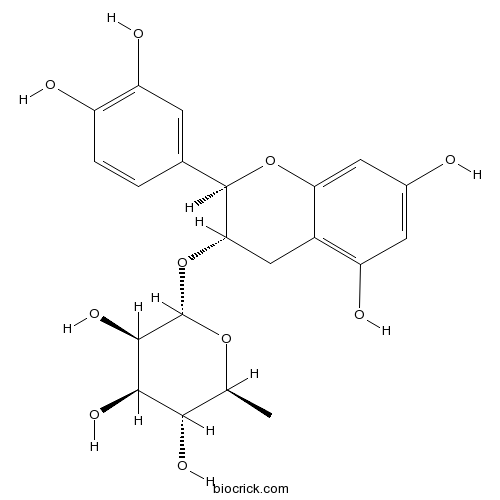Catechin 3-rhamnosideCAS# 103630-03-1 |

Quality Control & MSDS
3D structure
Package In Stock
Number of papers citing our products

| Cas No. | 103630-03-1 | SDF | Download SDF |
| PubChem ID | 21626704 | Appearance | Powder |
| Formula | C21H24O10 | M.Wt | 436.4 |
| Type of Compound | Flavonoids | Storage | Desiccate at -20°C |
| Solubility | Soluble in Chloroform,Dichloromethane,Ethyl Acetate,DMSO,Acetone,etc. | ||
| Chemical Name | (2S,3R,4R,5R,6S)-2-[[(2R,3S)-2-(3,4-dihydroxyphenyl)-5,7-dihydroxy-3,4-dihydro-2H-chromen-3-yl]oxy]-6-methyloxane-3,4,5-triol | ||
| SMILES | CC1C(C(C(C(O1)OC2CC3=C(C=C(C=C3OC2C4=CC(=C(C=C4)O)O)O)O)O)O)O | ||
| Standard InChIKey | KYLFHITXPCWYAL-HLBABLIESA-N | ||
| Standard InChI | InChI=1S/C21H24O10/c1-8-17(26)18(27)19(28)21(29-8)31-16-7-11-13(24)5-10(22)6-15(11)30-20(16)9-2-3-12(23)14(25)4-9/h2-6,8,16-28H,7H2,1H3/t8-,16-,17-,18+,19+,20+,21-/m0/s1 | ||
| General tips | For obtaining a higher solubility , please warm the tube at 37 ℃ and shake it in the ultrasonic bath for a while.Stock solution can be stored below -20℃ for several months. We recommend that you prepare and use the solution on the same day. However, if the test schedule requires, the stock solutions can be prepared in advance, and the stock solution must be sealed and stored below -20℃. In general, the stock solution can be kept for several months. Before use, we recommend that you leave the vial at room temperature for at least an hour before opening it. |
||
| About Packaging | 1. The packaging of the product may be reversed during transportation, cause the high purity compounds to adhere to the neck or cap of the vial.Take the vail out of its packaging and shake gently until the compounds fall to the bottom of the vial. 2. For liquid products, please centrifuge at 500xg to gather the liquid to the bottom of the vial. 3. Try to avoid loss or contamination during the experiment. |
||
| Shipping Condition | Packaging according to customer requirements(5mg, 10mg, 20mg and more). Ship via FedEx, DHL, UPS, EMS or other couriers with RT, or blue ice upon request. | ||
| Description | 1. Catechin 3-rhamnoside has antioxidant activity. |

Catechin 3-rhamnoside Dilution Calculator

Catechin 3-rhamnoside Molarity Calculator
| 1 mg | 5 mg | 10 mg | 20 mg | 25 mg | |
| 1 mM | 2.2915 mL | 11.4574 mL | 22.9148 mL | 45.8295 mL | 57.2869 mL |
| 5 mM | 0.4583 mL | 2.2915 mL | 4.583 mL | 9.1659 mL | 11.4574 mL |
| 10 mM | 0.2291 mL | 1.1457 mL | 2.2915 mL | 4.583 mL | 5.7287 mL |
| 50 mM | 0.0458 mL | 0.2291 mL | 0.4583 mL | 0.9166 mL | 1.1457 mL |
| 100 mM | 0.0229 mL | 0.1146 mL | 0.2291 mL | 0.4583 mL | 0.5729 mL |
| * Note: If you are in the process of experiment, it's necessary to make the dilution ratios of the samples. The dilution data above is only for reference. Normally, it's can get a better solubility within lower of Concentrations. | |||||

Calcutta University

University of Minnesota

University of Maryland School of Medicine

University of Illinois at Chicago

The Ohio State University

University of Zurich

Harvard University

Colorado State University

Auburn University

Yale University

Worcester Polytechnic Institute

Washington State University

Stanford University

University of Leipzig

Universidade da Beira Interior

The Institute of Cancer Research

Heidelberg University

University of Amsterdam

University of Auckland

TsingHua University

The University of Michigan

Miami University

DRURY University

Jilin University

Fudan University

Wuhan University

Sun Yat-sen University

Universite de Paris

Deemed University

Auckland University

The University of Tokyo

Korea University
- Cnidimol A
Catalog No.:BCN7167
CAS No.:103629-80-7
- Sumatriptan Succinate
Catalog No.:BCC2502
CAS No.:103628-48-4
- Sumatriptan
Catalog No.:BCC5645
CAS No.:103628-46-2
- (±)-5'-Chloro-5'-deoxy-ENBA
Catalog No.:BCC7716
CAS No.:103626-26-2
- H-Phe(2-Cl)-OH
Catalog No.:BCC3165
CAS No.:103616-89-3
- Janolusimide
Catalog No.:BCN1840
CAS No.:103612-45-9
- RETRA hydrochloride
Catalog No.:BCC2415
CAS No.:1036069-26-7
- 5,7-Dimethoxyflavanone
Catalog No.:BCN3569
CAS No.:1036-72-2
- Isookanin
Catalog No.:BCN6476
CAS No.:1036-49-3
- P005672 hydrochloride
Catalog No.:BCC6406
CAS No.:1035979-44-2
- Lansoprazole
Catalog No.:BCC1058
CAS No.:103577-45-3
- TAK-733
Catalog No.:BCC4587
CAS No.:1035555-63-5
- Ondansetron hydrochloride dihydrate
Catalog No.:BCC4213
CAS No.:103639-04-9
- 2-Carbamoyl-3-hydroxy-1,4-naphthoquinone
Catalog No.:BCC8567
CAS No.:103646-20-4
- Mirificin
Catalog No.:BCN2783
CAS No.:103654-50-8
- Dihydrobonducellin
Catalog No.:BCN3731
CAS No.:103680-87-1
- YK-4-279
Catalog No.:BCC2065
CAS No.:1037184-44-3
- Rehmaglutin D
Catalog No.:BCN5851
CAS No.:103744-84-9
- Fasudil
Catalog No.:BCC5262
CAS No.:103745-39-7
- Shionone
Catalog No.:BCN1274
CAS No.:10376-48-4
- R428
Catalog No.:BCC3692
CAS No.:1037624-75-1
- Gimeracil
Catalog No.:BCC2296
CAS No.:103766-25-2
- Ganoderic acid C2
Catalog No.:BCN3036
CAS No.:103773-62-2
- MBX-2982
Catalog No.:BCC1732
CAS No.:1037792-44-1
Three - (-) Catechin-O-Rhamnosides from the Eastern Nigeria Mistletoe with Potent Immunostimulatory and Antioxidant Activities
J. Biomol. Res. Ther., 2012, 1(1):1-6.
In an attempt to provide further convincing evidence for the variously reported immunomodulatory potentials of mistletoes, bioassay-guided fractionation of the eastern Nigeria mistletoe afforded three compounds: - (-) catechin- 7-O-rhamnoside (1), - (-) catechin-3-O- rhamnoside (Catechin 3-rhamnoside,2) and a 4′-methoxy-7-O-rhamnoside (3). Their effects on C57BL6 mice splenocytes proliferation and expression of CD69 molecule were determined using flow cytometry techniques and compared to Lipopolysaccharide (LPS; 10 μg/ml) and Concanavalin A (ConA; 2 μg/ml) as standards. The antioxidant study was by the DPPH model with ascorbic acid as standard. The compounds (1-3) at 100 μg/ml showed statistically significant (p<0.05) stimulatory activity with values of 91.49 ± 0.22%, 95.17 ± 0.01% and 94.23 ± 0.07% respectively compared to 2.65 ± 0.33% for the unstimulated control. However, the CD69 expression assay showed only moderate stimulation. Their measured antioxidant potentials (effective concentration; EC50) were high (≤ 55.42 ± 0.99 mg/ml) when compared to ascorbic acid (17.6 ± 1.78 mg/ml). Characterization of the compounds was achieved by chromatographic and spectroscopic methods.


